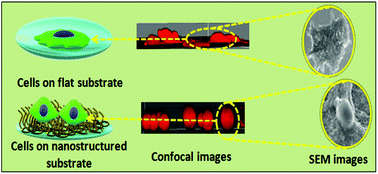Designing 3D-nanosubstrates mimicking biological cell growth: pitfalls of using 2D substrates in the evaluation of anticancer efficiency†
Abstract
Designing nano-substrates (NS) that support three-dimensional (3D) cell growth using physico-chemical interventions mimicking the cellular microenvironment is highly challenging. Here we report NS that assist 3D cell development (3D NS) using multi-components on a glass substrate (2D GS), which mimics the ex vivo tissue microenvironment and promotes 3D cell growth superior to conventional 2D cell culturing methodologies. 3D NS were chemically fabricated by linking the combination of advanced materials imparting different physico-chemical traits, for example, multiwalled carbon nanotubes (CNT), graphene (G), bovine serum albumin (BSA), and iron oxide magnetic nanoparticles (MNP). We compared cell–substrate interactions resulting in cellular morphological changes, influence on the cell circularity index (CI), nuclear-cytoplasmic ratios (N/C), and nuclear compression or derangements using human colorectal carcinoma cells (HCT116) and cervical cancer (HeLa) cells. We observed the increase in N/C, extended on the 3D NS micro-environment as indicative of cellular adaptation and the transformation. HCT116 and HeLa cells on 2D GS showed an N/C ratio <0.3, and 3D NS cultured cells exhibited a higher N/C ratio (>0.5). The most significant increase in the ratio, relative to arrested cell spreading, was observed with G-3D NS. Furthermore, 3D NS were evaluated for the cell viability differentiations using the anticancer drug doxorubicin (Dox). The drug-treated cells on 3D NS demonstrated far-displaced N/C ratios compared to 2D GS. In conclusion, 3D NS systems implicate an ‘in vitro to in vivo’ relevance for the outcome in cell biology, cell proliferation and migration, and in anticancer drug efficacy evaluation.



 Please wait while we load your content...
Please wait while we load your content...